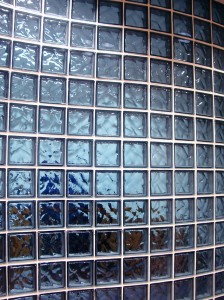Using glass block in interior design
Glass block inspires strong feelings. People either love it or hate it. And it can be difficult to know what to do with glass blocks. As architectural items, glass blocks were first used in the years leading up to World War II in France. They were invented in France in the early 1900’s, but it wasn’t until machine manufacturing came along that glass block entered into regular use in architecture and interior design.
Glass block can be versatile
Glass block is attractive to homeowners for a number of reasons. First, they’re versatile. They are made in a number of uniform sizes, so they can be used to fill spaces neatly.
Thanks to their design, they’re also good at creating privacy. The glass surface of glass block isn’t uniform. Because there’s a relatively large gap between the sides of the block, it’s virtually impossible to see anything clearly through the block, but the block design admits light nicely. Glass block is also easy to maintain.
Put all of those qualities together, and you can create some nice options for bathroom and basement windows, and you can also use them to create interior space dividers.
You can use glass block to make a “privacy wall” anywhere in your home. Whether you’re trying to provide some “modesty space” in a bathroom or dressing room, or you’re trying to minimize distractions in a home office, glass block offers a versatile option.
Sometimes, you may “inherit” glass block, and you may not know exactly how you want to treat it. Glass block, like other glass surfaces, can be coated effectively with Glassprimer™ glass paint. Glassprimer™ glass paint comes in virtually any color, and can create a translucent or opaque, UV-resistant, moisture resistant coating that will stand up in the toughest environments for years.
Glassprimer™ glass paint will still allow light to penetrate the glass, but can create a fresh new look for glass block. It’s important to remember that Glassprimer™ glass paint is designed to create a permanent coating on the glass. Once the paint is cured, it cannot be removed. The paint doesn’t simply dry on the glass surface. Instead, it modifies the surface of the glass to create a permanent bond.
If you’d like more information about Glassprimer™ glass paint, please check out the rest of our site. If you’d like to purchase Glassprimer™ glass paint, please visit our online store .
Photo Credit: Alfonso Diaz, via FreeImages.com

